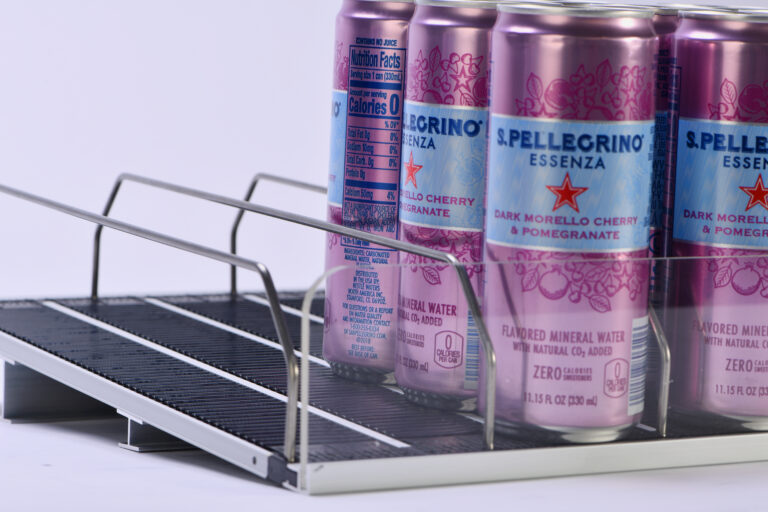Supermarkets and retail stores are always looking for ways to keep their shelves neat, their products visible, and their staff focused on real value-added work—not constant restocking. That’s where shelf roller track solutions come in. But here’s the big question: are they right for everyone?
Shelf roller tracks are a smart investment for businesses that sell fast-moving consumer goods (FMCGs), especially cold-chain products and bottled beverages, where front-facing inventory and shelf organization affect both efficiency and sales.
If you’ve been wondering whether this system is worth the upgrade, stick around. We’ll walk you through who should seriously consider making the switch—and why it might not be a perfect fit for everyone.
Who benefits most from shelf roller tracks?
If you’ve ever shopped in a well-organized convenience store or supermarket, chances are you’ve experienced shelf roller tracks without knowing it. These systems help push products forward automatically, thanks to gravity-fed rollers installed at the base of each shelf.
Businesses that sell packaged foods, beverages, dairy, cosmetics, or pharmaceutical products are the biggest winners here.
But let’s unpack this in more detail.
Why high-volume retailers love roller tracks
These retailers deal with hundreds of SKUs and daily restocking routines. Roller shelves reduce the manual labor needed and maintain front-facing product displays without employee intervention.
| Feature | Benefit |
|---|---|
| Gravity-fed system | Keeps items front-facing without pushing |
| Easy restocking | Stock from the back while the front remains tidy |
| Reduces labor cost | Staff spends less time fixing displays |
| Works with labels | Allows integration with price tags and ESLs |
Why product visibility matters
Products at the back of traditional flat shelves often get missed by customers. Roller tracks help reduce this issue. When one item is taken, the rest roll forward automatically.
That means fewer expired products, better rotation, and better customer experience.
And here’s something to think about: studies show that neatly aligned products can improve perceived value and increase sales by up to 12%. Roller tracks can help you do that consistently—without extra labor.
Are shelf roller tracks ideal for supermarkets?
Supermarkets are one of the biggest adopters of this system. Why? Because they sell fast-turnover items in volume. Think milk cartons, soft drinks, juice boxes, or even canned foods. Roller tracks ensure these items stay front-facing and easy to grab.
Yes, shelf roller track systems are an excellent fit for supermarkets, especially in refrigerated aisles.
Let’s take a closer look.
Supermarkets run on restocking efficiency
In large supermarkets, staff can’t monitor every shelf 24/7. Roller systems simplify their job. Instead of adjusting every item manually, they can just load new stock from the back.
| Shelf Type | Roller Track Benefit |
|---|---|
| Refrigerated shelf | Keeps cold items aligned and fresh |
| Beverage shelf | Handles heavy bottles easily |
| Dairy product racks | Supports rotation for expiry management |
| Promotional shelves | Maintains neatness during high-traffic sales |
Temperature-sensitive goods benefit most
Products in cold storage or freezer zones often need more careful display. A roller system works well here because it limits employee contact and keeps things hygienic.
Plus, roller tracks made from PET or other moisture-resistant materials won’t warp or degrade over time. That’s important when you’re dealing with wet environments or temperature fluctuations.
Should convenience stores invest in roller shelf systems?
Convenience stores work with limited staff and smaller spaces. Every square inch needs to be optimized. Inventory has to be easy to stock, clean, and sell.
Yes—roller shelf systems are a great fit for convenience stores with packaged goods and chilled items.
Let’s go further.
Why time matters more in small stores
In convenience stores, employees often multitask between customer service, cleaning, and stocking. With roller tracks, they can save time. Products stay in order longer, and shelves look more professional without constant adjustment.
Here’s where roller shelves really make a difference:
- Cold drink refrigerators
- Dairy and yogurt sections
- Grab-and-go snack racks
- Cigarette display units (in regulated regions)
Do they fit into small shelf spaces?
Absolutely. Most roller tracks are modular and can be cut to size. That means even tight spaces or corner shelves can benefit. And since many systems support custom mounting (adhesive, screw, or clip-on), installation is usually fast.
Roller shelves also reduce the risk of mess caused by customer handling—products always slide back into place.
Can shelf roller tracks improve cold chain product displays?
Cold chain logistics are strict. Products must stay cold, fresh, and accessible. If customers spend too long digging through shelves, they compromise temperature control.
Shelf roller tracks are designed to support cold-chain product rotation while preserving cold integrity and visibility.
Now let’s see why this matters.
The challenge of cold chain merchandising
Cold-chain shelves—especially open coolers—are often hard to keep organized. Staff can’t always restock on demand, and clutter leads to poor airflow.
Roller tracks fix that by:
- Reducing shelf clutter
- Speeding up stock rotation
- Improving airflow around products
- Maintaining neat front-facing presentation
Materials matter in cold environments
PET-based roller tracks resist humidity and moisture better than standard plastic. That’s why they’re used in frozen food aisles or under mist-sprayed produce sections. Unlike metal systems, PET won’t rust or corrode.
If your store moves dairy, deli items, or chilled drinks, roller tracks are worth the investment.
| Cold Chain Product | Shelf Challenge | Roller Track Solution |
|---|---|---|
| Yogurt | Stock rotation & space | Gravity alignment |
| Fresh juice | Heavy packaging | Easy gliding |
| Milk cartons | Expiry control | FIFO-friendly loading |
| Packaged meat | Hygiene concern | Minimal touch restocking |
How do shelf roller tracks help with beverage merchandising?
Walk into any store and look at the beverage aisle. Whether it’s bottled water, soda, or energy drinks, the neat rows didn’t stay that way on their own. That’s the work of roller tracks.
Beverage displays gain the most visual and operational value from roller shelf systems.
Here’s why.
Beverage packaging is heavy and awkward
Pushing rows of 1.5L bottles back into place every hour? That’s exhausting for staff. Roller tracks remove that task.
They:
- Handle weight efficiently
- Roll easily even when full
- Reduce staff fatigue
- Keep alignment neat
| Beverage Type | Shelf Roller Benefit |
|---|---|
| Water bottles | Neat rows, stable stacking |
| Sodas | Support heavier loads |
| Juices | Faster front-facing after purchase |
| Alcohol | Safer shelf organization |
They improve impulse buying
Neatness matters when customers are making fast decisions. If your drinks are messy, they might pick a competitor’s instead. Roller shelves make every item look like it just got restocked.
That’s the kind of polish that increases perceived quality—and boosts your sales per square meter.
Do shelf roller systems reduce restocking labor?
Yes. That’s one of the biggest reasons they’re so popular in modern retail.
Roller track systems significantly reduce the frequency and manual effort required for shelf organization and restocking.
Let’s dig into why that’s such a big deal.
The labor savings are real
Retail labor costs keep climbing. Time spent on low-value tasks—like pushing products forward—is time lost.
Roller shelves automate that process. When a customer takes a product, the rest glide forward. That means:
- No need to touch every item
- Faster refill from the back
- No messy “product gaps”
- Reduced staff workload
| Without Roller Tracks | With Roller Tracks |
|---|---|
| Manual product pushing | Automatic item rolling |
| Frequent visual checks | Fewer shelf inspections |
| Multiple restocks per shift | 1–2 efficient loads per day |
| Visual inconsistency | Uniform shelf presentation |
Why stores love this
Managers love predictable systems. When you know exactly how often a shelf needs restocking, you can schedule smarter. That leads to better task management, less stress, and fewer out-of-stock problems.
What retail categories gain the most efficiency from roller shelves?
Not every retailer needs roller systems—but many can benefit.
Retail categories that involve cold, fast-moving, or heavy-packaged goods gain the most from roller shelf systems.
Let’s list a few.
Ideal sectors for roller tracks
- Supermarkets: For all cold, drink, dairy, and snack aisles
- Convenience stores: To reduce labor and keep displays tidy
- Pharmacies: For vitamins, cosmetics, and over-the-counter items
- Gas stations: For grab-and-go drinks and packaged goods
- Liquor stores: For wine and spirits shelving
Roller tracks are also becoming popular in non-food retail, like:
- Pet stores (pet food cans)
- Cosmetics chains (face masks, creams)
- Health stores (supplements, protein drinks)
As long as the product fits a shelf and has packaging that can roll—this system works.
Conclusion
So, who should invest in shelf roller track solutions? The answer is simple: any retailer who values time, efficiency, and presentation. From supermarkets to small stores, roller shelves can change how you display, manage, and sell your products.
They’re not for every category, but if you move goods quickly—or want a more professional look—it might be time to give them a closer look. Thanks for reading.



